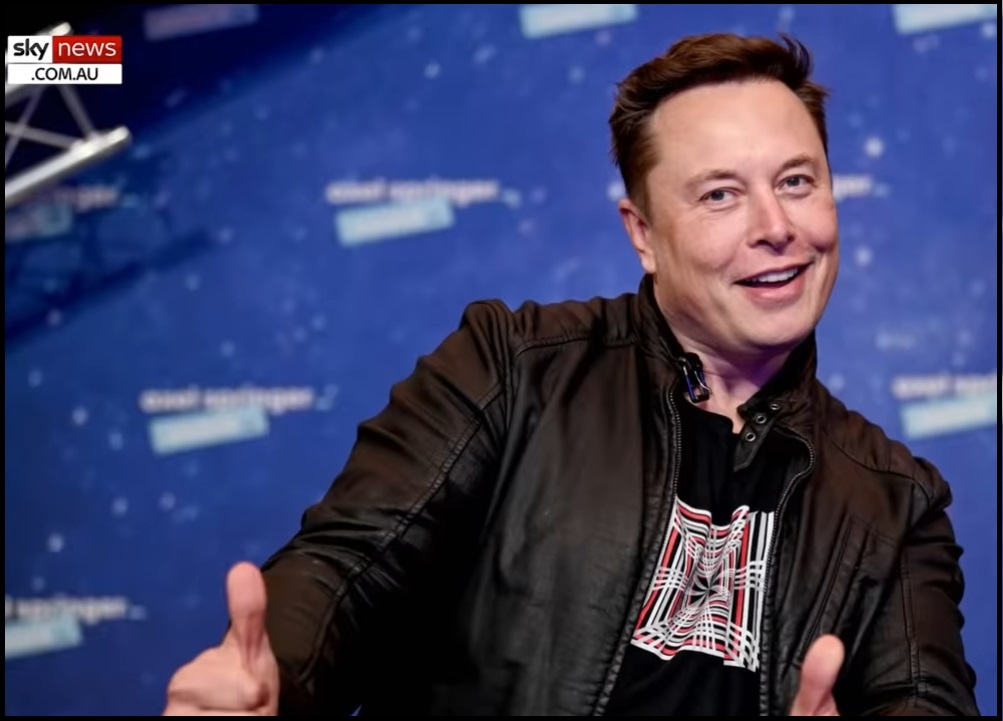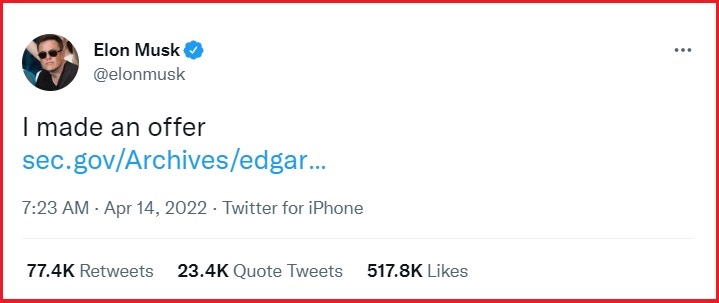
The richest man in the world, Tesla CEO Elon Musk, made an offer to purchase the Twitter platform for a price of $41 billion. The offer represents a value of 38% more than the current evaluation. [SEC FILING HERE] The offer is filed with the US Securities and Exchange Commission proposing a full takeover for $54.20 per share in cash.

Within the filing Elon Musk states his intentions:
“I invested in Twitter as I believe in its potential to be the platform for free speech around the globe, and I believe free speech is a societal imperative for a functioning democracy. However, since making my investment I now realize the company will neither thrive nor serve this societal imperative in its current form. Twitter needs to be transformed as a private company.
As a result, I am offering to buy 100% of Twitter for $54.20 per share in cash, a 54% premium over the day before I began investing in Twitter and a 38% premium over the day before my investment was publicly announced. My offer is my best and final offer and if it is not accepted, I would need to reconsider my position as a shareholder. Twitter has extraordinary potential. I will unlock it. (SEC LINK)
What Elon Musk appears to be doing is perhaps the biggest story that few understand.
I share this perspective having spent thousands of hours in the past several years deep in the weeds of tech operating systems, communication platforms, and the issue of simultaneous users. What Twitter represents, and what Musk is attempting, is not what most would think.
In the big picture of tech platforms, Twitter, as an operating model, is a massive high-user commenting system.
Twitter is not a platform built around a website; Twitter is a platform for comments and discussion that operates in the sphere of social media. As a consequence, the technology and data processing required to operate the platform does not have an economy of scale.
There is no business model where Twitter is financially viable to operate…. UNLESS the tech architecture under the platform was subsidized.
In my opinion, there is only one technological system and entity that could possibly underwrite the cost of Twitter to operate. That entity is the United States Government, and here’s why.
 Unlike websites and other social media, Twitter is unique in that it only represents a platform for user engagement and discussion. There is no content other than commentary, discussion and the sharing of information – such as linking to other information, pictures, graphics, videos url links etc.
Unlike websites and other social media, Twitter is unique in that it only represents a platform for user engagement and discussion. There is no content other than commentary, discussion and the sharing of information – such as linking to other information, pictures, graphics, videos url links etc.
In essence, Twitter is like the commenting system on the CTH website. It is the global commenting system for users to share information and debate. It is, in some ways, like the public square of global discussion. However, the key point is that user engagement on the platform creates a massive amount of data demand.
Within the systems of technology for public (user engagement) commenting, there is no economy of scale. Each added user represents an increased cost to the operation of the platform, because each user engagement demands database performance to respond to the simultaneous users on the platform. The term “simultaneous users” is critical to understand because that drives the cost.
According to the Wall Street Journal, Twitter has approximately 217 million registered daily users, and their goal is to expand to 315 million users by the end of 2023. Let me explain why things are not what they seem.
When people, users, operate on a tech platform using the engagement features, writing comments, hitting likes, posting images, links etc, the user is sending a data request to the platforms servers. The servers must then respond allowing all simultaneous users to see the change triggered by the single user.
Example: when you hit the “like” button feature on an engagement system, the response (like increasing by one) must not only be visible to you, but must also be visible to those simultaneously looking at the action you took. If 100,000 simultaneous users are looking at the same thing, the database must deliver the response to 100,000 people. As a result, the number of simultaneous users on a user engagement platform drives massive performance costs. In the example above, a single action by one person requires the server to respond to 100,000 simultaneous users with the updated data.
As a consequence, when a commenting platform increases in users, the cost not only increases because of that one user, the cost increases because the servers need to respond to all the simultaneous users. Using CTH as an example, 10,000 to 15,000 simultaneous commenting system users, engaging with the servers, costs around $4,500/mo.
This is why most websites, even big media websites, do not have proprietary user engagement, i.e. commenting systems. Instead, most websites use third party providers like Disqus who run the commenting systems on their own servers. Their commenting systems are plugged in to the website; that defers the cost from the website operator, and the third party can function as a business by selling ads and controlling the user experience. [It also sucks because user privacy is non existent]
The key to understanding the Twitter dynamic is to see the difference between, (a) running a website, where it doesn’t really matter how many people come to look at the content (low server costs), and (b) running a user engagement system, where the costs to accommodate the data processing -which increase exponentially with a higher number of simultaneous users- are extremely expensive. Twitter’s entire platform is based on the latter.
There is no economy of scale in any simultaneous user engagement system. Every added user costs exponentially more in data-processing demand, because every user needs a response, and every simultaneous user (follower) requires the same simultaneous response. A Twitter user with 100 followers (simultaneously logged in) that takes an action – costs less than a Twitter user with 100,000 followers (simultaneously logged in), that takes an action.
If you understand the cost increases in the data demand for simultaneous users, you can see the business model for Twitter is non-existent.
Bottom line, more users means it costs Twitter more money to operate. The business model is backwards from traditional business. More customers = higher costs, because each customer brings more simultaneous users….. which means exponentially more data performance is needed.
User engagement features on Twitter are significant, because that’s all Twitter does. Not only can users write comments, graphics, memes, videos, but they can also like comments, retweet comments, subtweet comments, bookmark comments, and participate in DM systems. That is a massive amount of server/data performance demand, and when you consider simultaneous users, it’s almost unimaginable in scale. That cost and capacity is also the reason why Twitter does not have an edit function.
With 217 million users, you could expect 50 million simultaneous users on Twitter during peak operating times. My back of the envelope calculations, which are really just estimations based on known industry costs for data performance and functions per second, would put the data cost to operate Twitter around at least $1 billion per month (minimum). In 2021, Twitter generated $5.1 billion in revenue, according to the Wall Street Journal.
There is no business model, even with paying subscribers, for Twitter to exist. As the business grows, the costs increase, and the costs to subscribers would grow. So, what is going on?
The only way Twitter, with 217 million users, could exist as a viable platform is if they had access to tech systems of incredible scale and performance, and those systems were essentially free or very cheap. The only entity that could possibly provide that level of capacity and scale is the United States Government – combined with a bottomless bank account.
If my hunch is correct, Elon Musk is poised to expose the well-kept secret that most social media platforms are operating on U.S. government tech infrastructure and indirect subsidy. Let that sink in.
The U.S. technology system, the assembled massive system of connected databases and server networks, is the operating infrastructure that offsets the cost of Twitter to run their own servers and database. The backbone of Twitter is the United States government.
There is simply no way the Fourth Branch of Government, the U.S. intelligence system writ large, is going to permit that discovery.

